
Rivers and Rails of Africa
March 31 - April 12, 2023
Mike and Judy Henderson
I'll leave this map up so you can see where we are.

+++++++++++++++++++++++++++
4/6/2023 (Thursday) This morning we are going to visit an African village, not far from where the Queen is moored.
Judy took this picture of me as we waited for our tour guide at the village landing.

Our tour guide for today is a village resident.

He began by describing the village and what the people do. While the village is "traditional", modern things have made their way into the village.
For example, housing. Note in this next picture, the structure with the thatch roof next to two with "tin" roofs. He explained that the thatch roof was less expensive but the problem was termites - they get into the thatch roof and destroy it, so it has to be replaced every two to three years. Houses with tin roofs avoid that problem, but are more expensive, hotter in summer, and noisier in the rain.
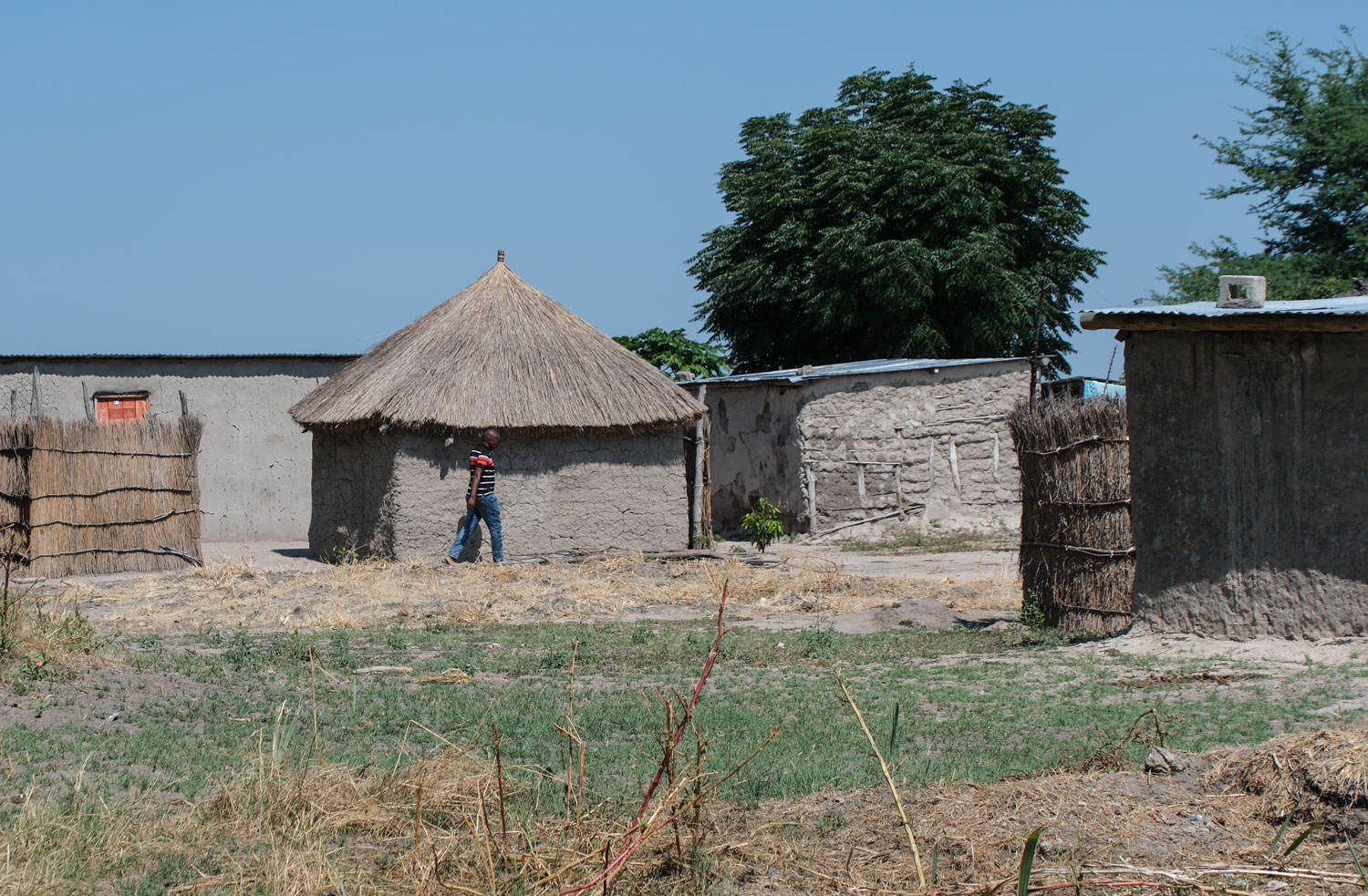
The house itself is constructed by putting poles into the ground and then running smaller poles across the uprights. They are tied together with fibrous material.
Then, mud is dabbed into the spaces between the poles. This is traditionally done by women and done after a rain, when mud is available. It was commented that women who work outside the village often ask for a day off after a rain so that they can work on a house.

Here's a house in process, with mud dabbed between the poles. Note how the tin roof extends out from the sides. If they didn't do that, rain could run down the walls and wash the mud away. Also, rain running off the roof splashes when it hits the ground and can erode the lower wall.

The final step is to put a smooth coat of mud over the wall to protect the wooden structure.

However, termites are the enemy of their houses, also. Termites get into the wooden structure and gradually destroy it, requiring the family to build a new house.
One of the villagers, who works on the Queen - and therefore, makes a decent income, is building a concrete block house. It is expected to take him several years to complete the house.

The other housing issue the villagers face is rising water from the Chobe River. Depending on precipitation in the area, the volume of water in the Chobe can change drastically. The river is shallow and when the flow increases, the river floods its banks. Houses built in the lower part of the village can be flooded, and essentially destroyed from erosion.
One thing I did not have time to understand is the governance of the village. Our guide mentioned that they have someone like a mayor who decides where a family can build their home. S/he can also marry couples. But that's all I heard. I don't know how that person is selected.
Regarding creeping modernity, the government has required composting toilets in the village. The tour director said that most people still just use the bush, leaving the composting toilets to those over 60 years of age. I think it was considered a privilege to be able to use the composting toilets.

Another government help was this water tower. Actually, there were several in the village. There's a solar panel on the tank, which provides power for a pump that pumps water from a well (also provided by the government). This provides easy access to water, although it does not appear that they have running water in their homes.

Even privately, modernity has crept into the lives of the villagers. We visited one home and were surprised to see a solar panel outside the door.

The wire from the solar panel runs to a 12 volt battery inside the house. Connected to the battery is an inverter which converts from 12 volts DC to 220 volts 50 Hz AC. Then a smartphone charger cube is plugged into the inverter to charge the two smartphones you can see on the right side of the picture.
There's a wire running up from the inverter. That wire feeds one (or more) LED bulbs on the ceiling to light the home at night.
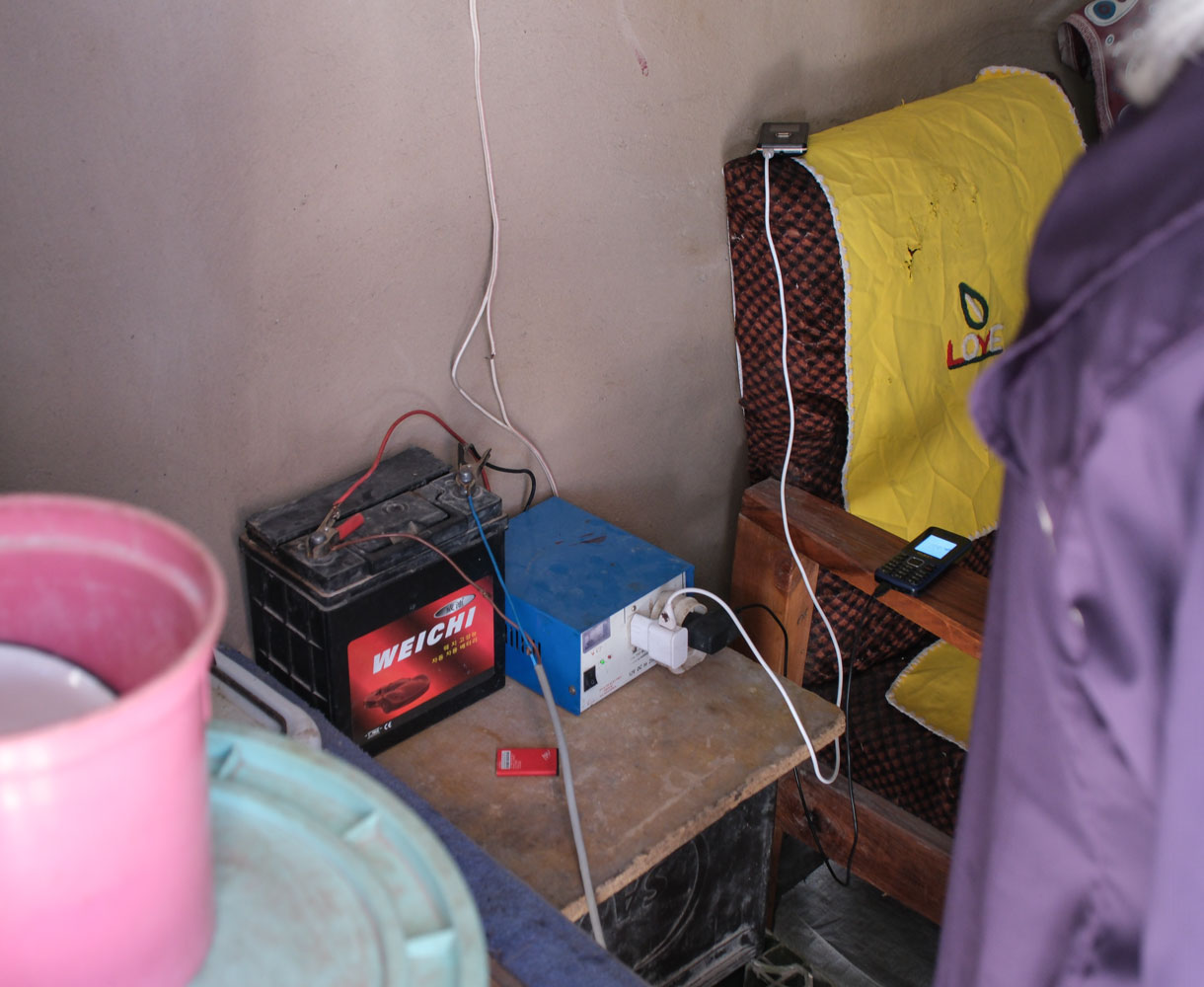
Here is the woman who owns this house. The interior is very nice.

The villagers put on a show for us, with some of the men drumming and the women dancing and singing.

I like photographing people's faces, and tried to capture a few while the show was going on.


The kids of the village were on the side, watching.

Here are some close-ups of a few of the kids.

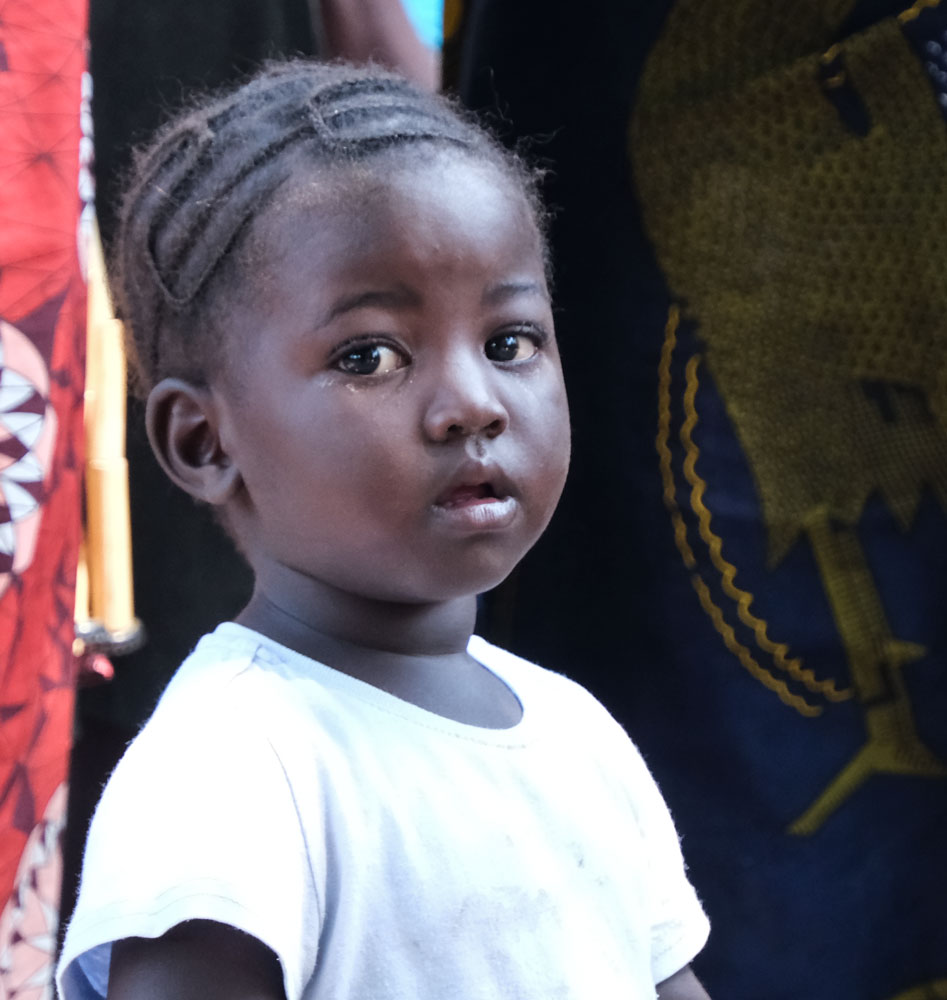
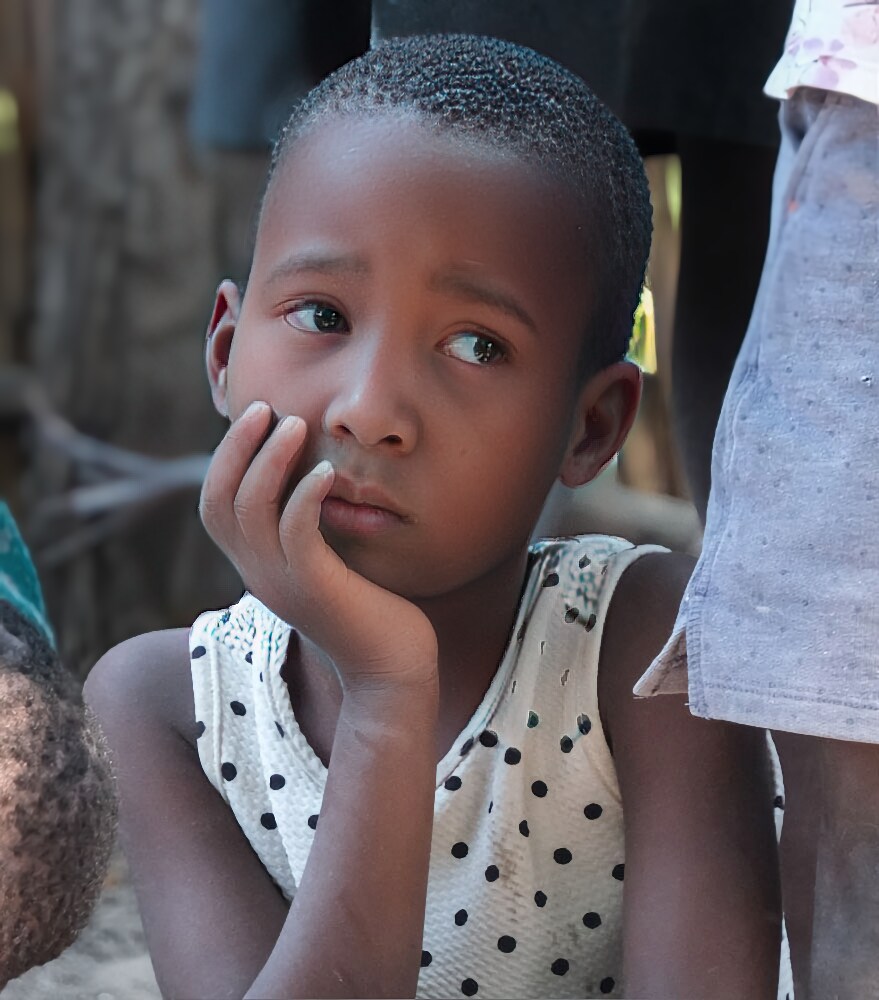
After the performance, we spent some time admiring displays of some of their crafts. We purchased a few bowls and baskets, mostly to help the villagers.

That was the end of our visit. On our way back to the Queen, our boat driver took us on safari for a while. Here's another White Fronted Bee-Eater that we've seen before.

Some cormorants in a tree.

A Crowned Cormorant drying his wings after diving into the water to catch a fish.
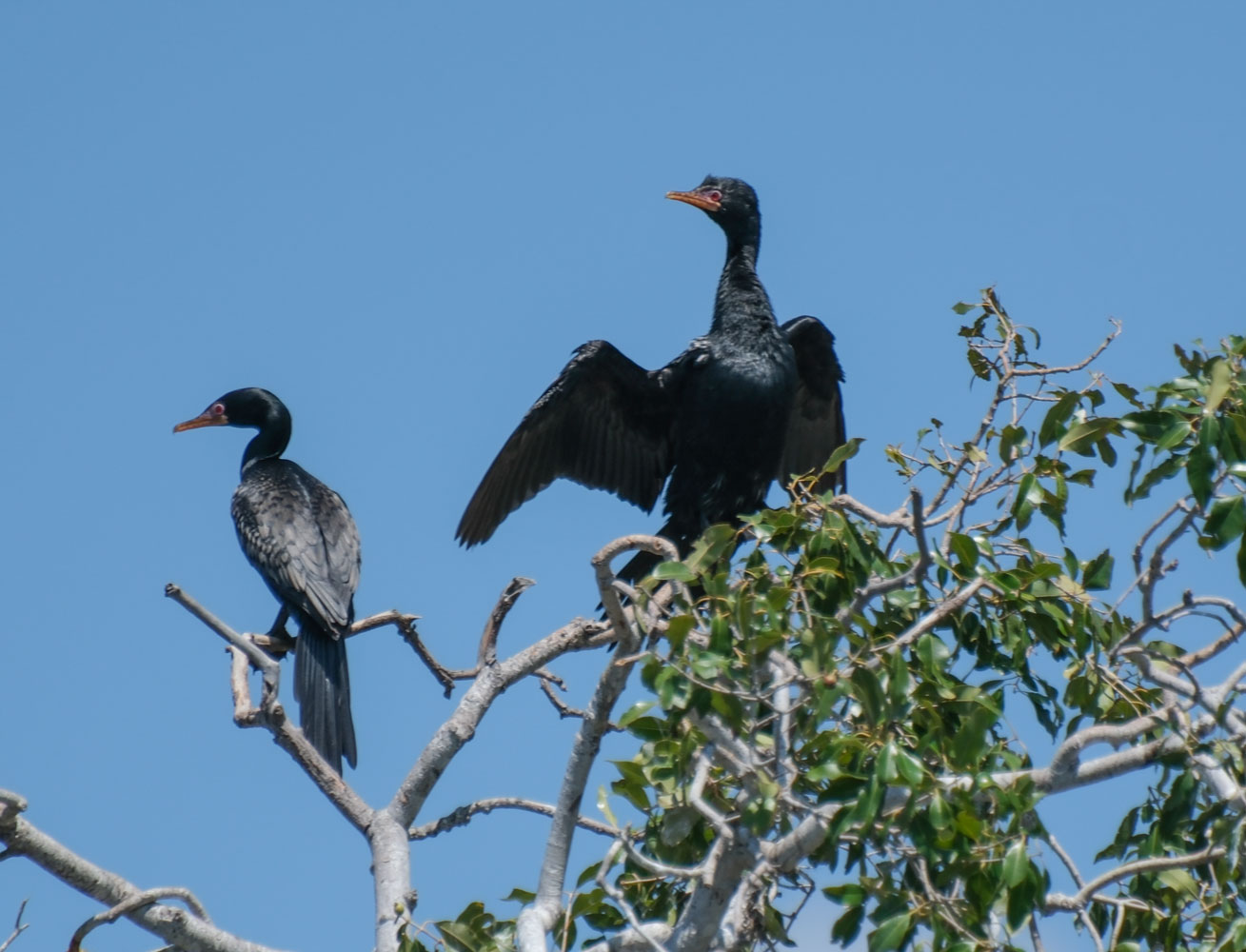
An Eastern Great Egret.

A couple of Blue Cheeked Bee-Eaters.

A Grey Heron.
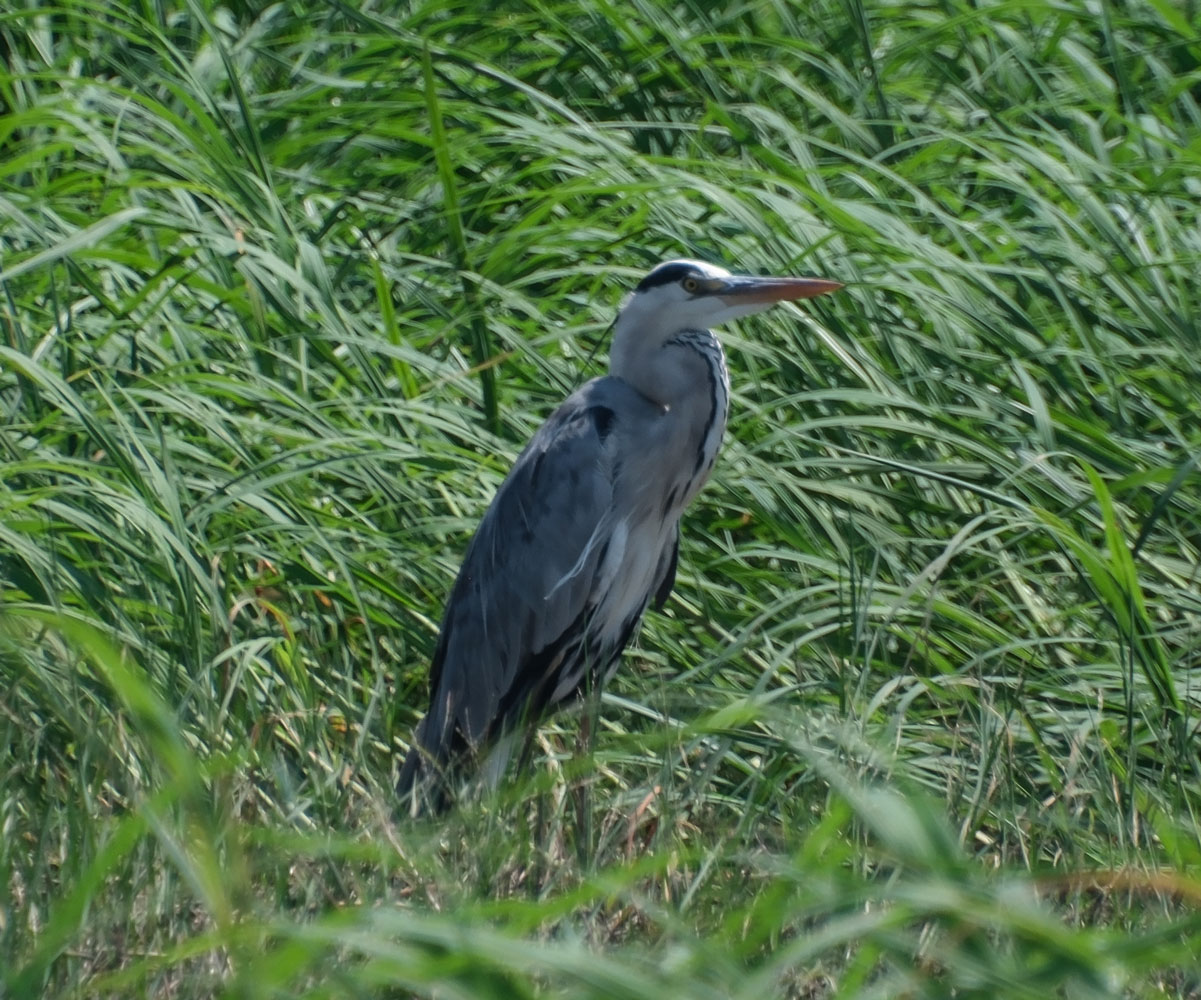
Another Grey Heron.

Another Wired Tailed Swallow, a cute, colorful bird. Very photogenic.

Here he is just taking off.

Caught him with his mouth open.

"You looking at me?" (From Taxi Driver.)
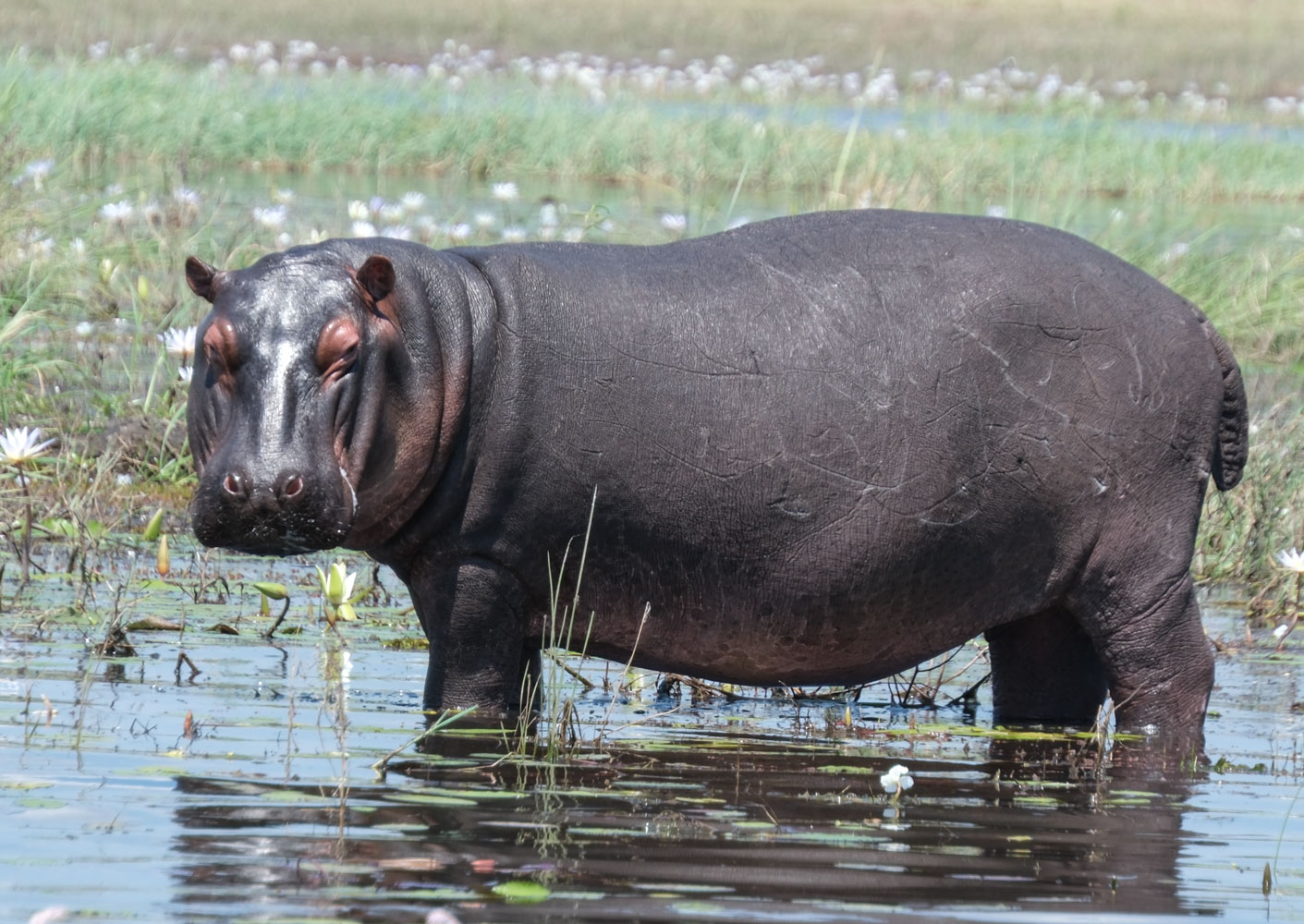
A group of elephants came running down to the shore.

It looked like two mothers and two children.

I have a bunch more pictures of the elephants, but I'll close with this one.

We headed back to the Queen for lunch. Another boat safari was scheduled for 3 - 6pm, but Judy and I were too tired. We stayed on board and took a nap.
That evening, we had the final dinner. We all gathered on the top deck and watched the sun set over the river, which didn't have a ripple in it.


Frank joined us. He had on a traditional African shirt.

We watched the moon rise in the west - it was the night of full moon.

The crew had prepared an African-themed dinner.

After dinner, the crew presented an African-themed show which included drums, singing and dancing.
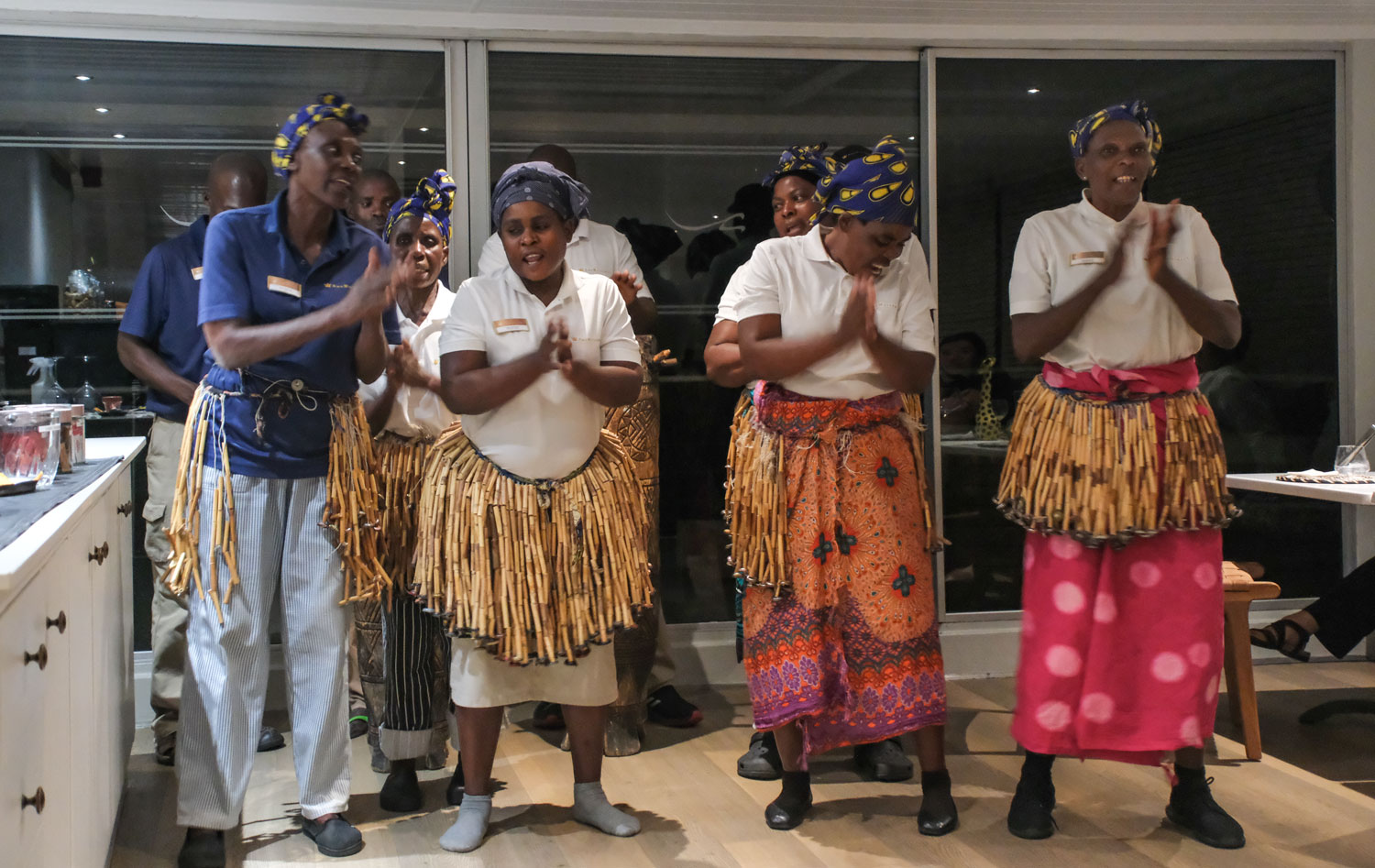
Here are the drummers.
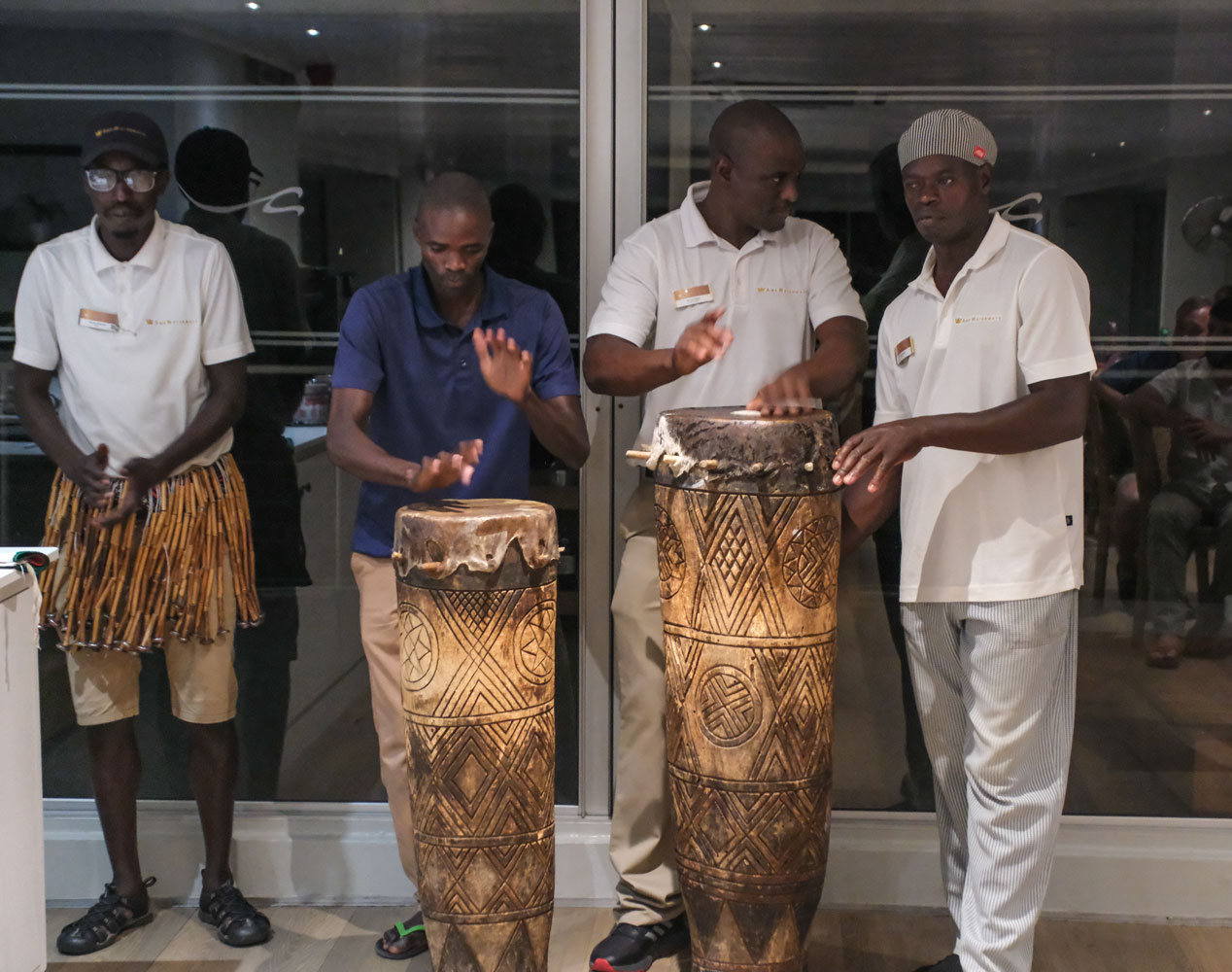
And some of the dancing.
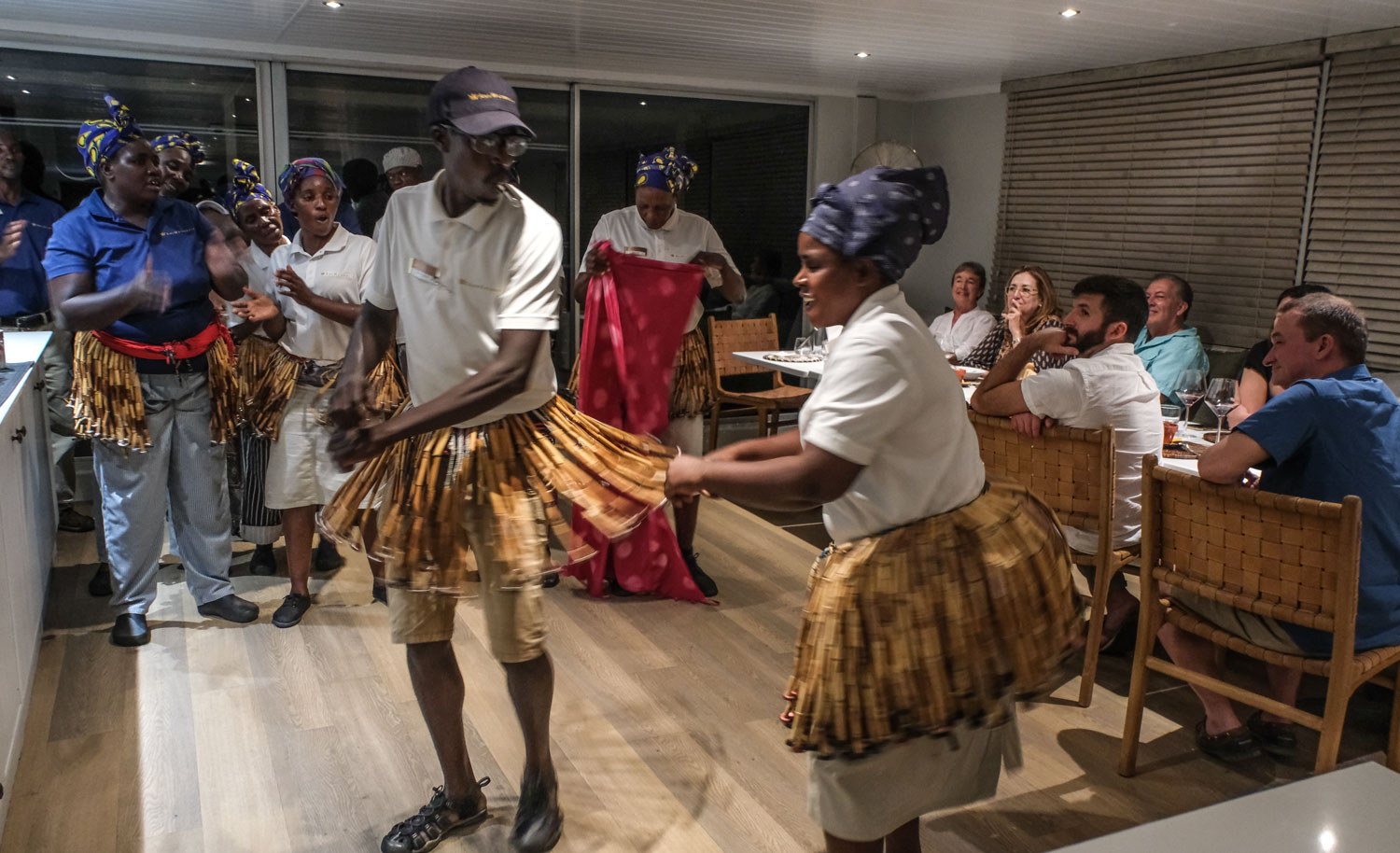
Isabel joined the dancers.


That was the end of our evening, and our last night on the Zambezi Queen.
+++++++++++++++++++++++++++
4/7/2023 (Friday) We depart the Zambezi Queen this morning and fly to Victoria Falls. The crew picked up our bags about 9:30 and our departure was scheduled for 10. Some of the crew lined up and sang as we departed.

We had to go to the Namibia passport office and "exit" Namibia, then to the Botswana passport office and "enter" Botswana. At that location, we boarded the bus to Victoria Falls.
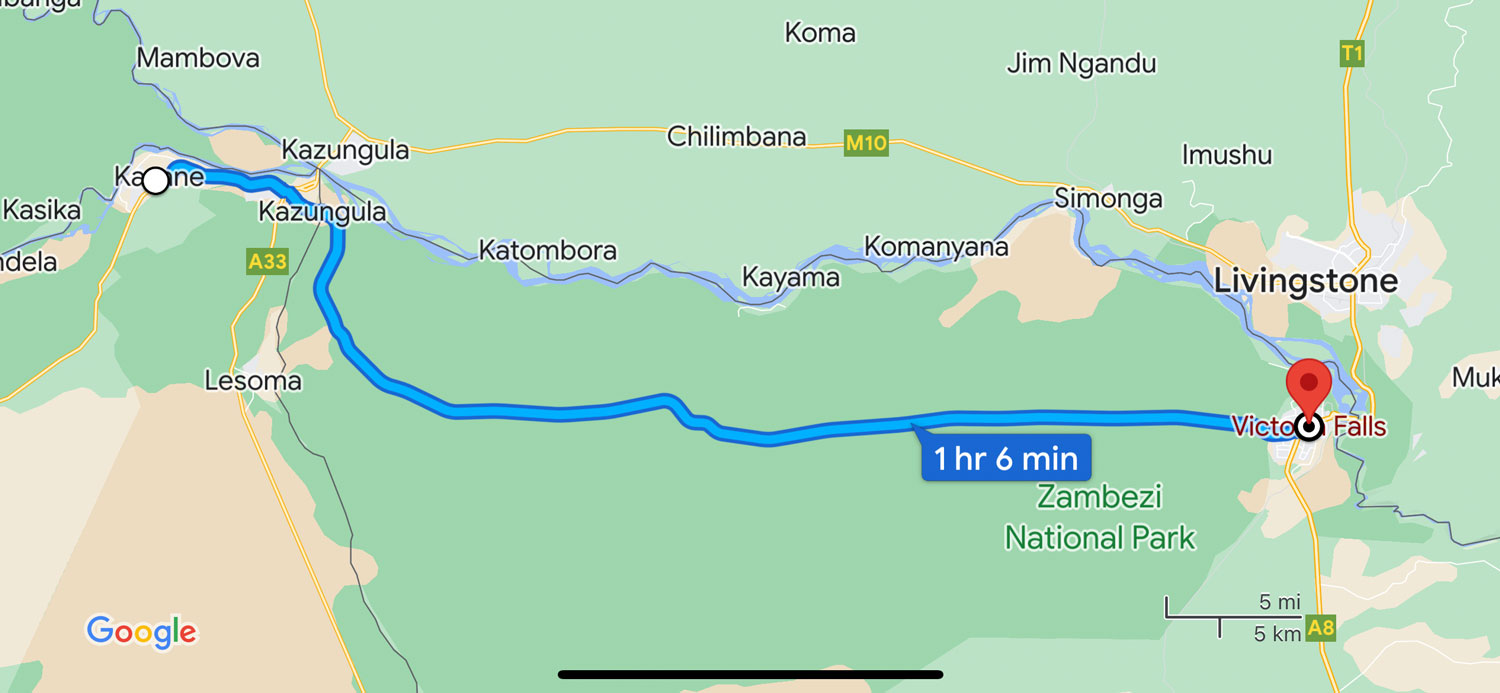
But Victoria Falls is in Zimbabwe so we have to go through a few more passport controls. Thank goodness for the privileges and immunities clause in the US constitution.
The passport office in Botswana was nice and modern - and not busy. Botswana has oil revenue and is a bit wealthier than other countries in the area.

The Zimbabwe passport office was a bit more hectic, and not nearly as modern.
Important note: The official currency of Zimbabwe is the US Dollar. If you go to an ATM in Zimbabwe and get cash, you will get US dollars.

But eventually, we arrived at the Victoria Falls Hotel.

We were met by the local AMA Waterways representative, Cynthia, who took very good care of us during our stay.

We stopped for a moment at the main entrance to the hotel. This front section of the hotel is rather narrow. It opens to an interior courtyard.

A wider view of the main entrance.
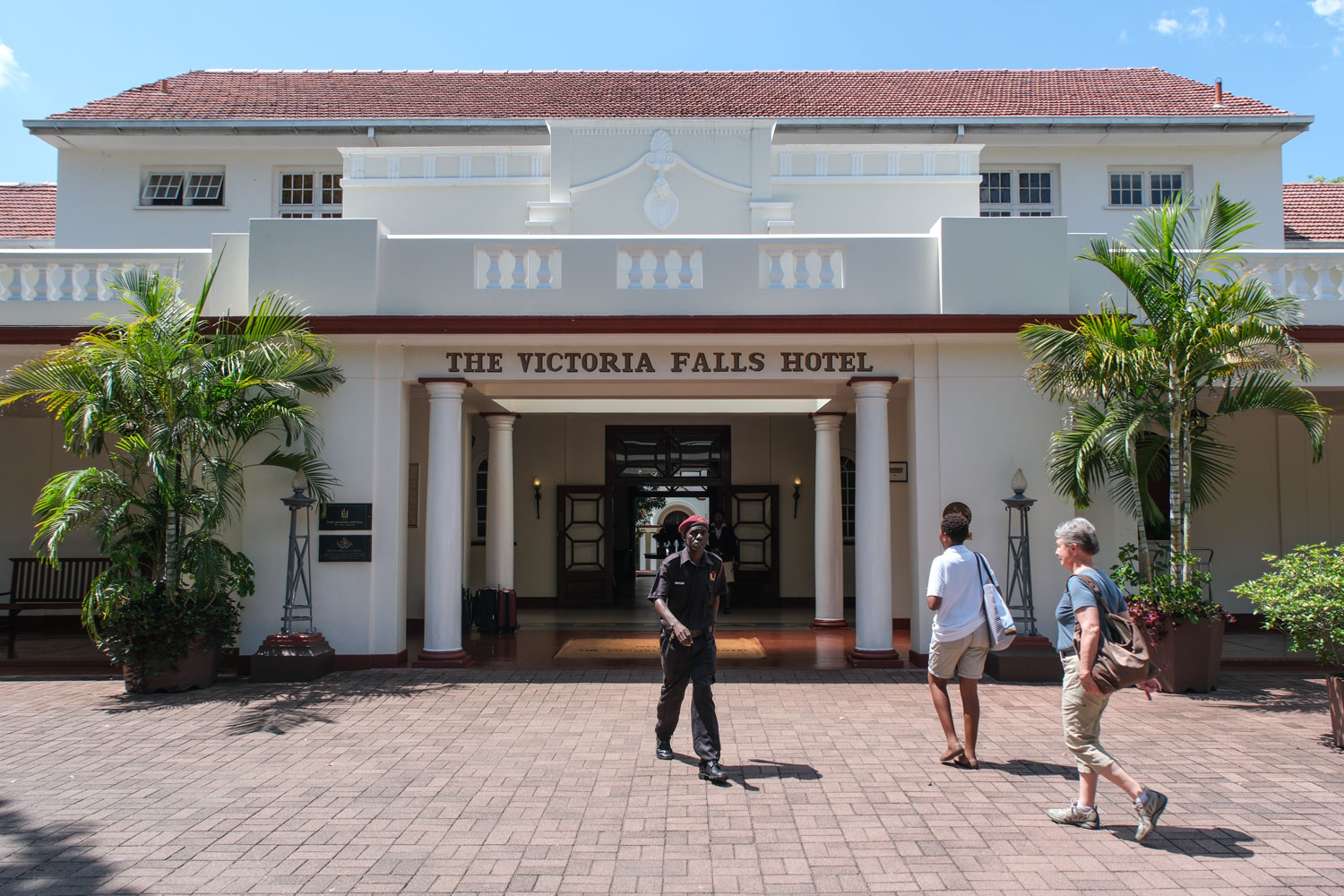
Another large building is on the other side of the courtyard. The hotel has a strong British influence.

While we waited for our rooms to be ready, we went to the restaurant and had lunch with Ana and Arnaldo. The restaurant is on the patio with a view toward the falls and the famous bridge.
The cloud you see is mist from the falls. The Kololo and Lozi people call it Mosi-oa-Tunya which roughly translates to "The Smoke that Thunders."

Here's a picture of the bridge that I took later in the day. There was a wonderful, well defined rainbow under the bridge but the camera just didn't capture it well.
The bridge has a single lane of traffic, a railroad track, and a pedestrian path. It was built in 1905. Cecil Rhodes required that the bridge be built close enough to the falls that the mist would fall on the trains that crossed it - and so that there would be a view of the falls for the passengers.
Note the bungee cords hanging from the bridge. Neither of us tried it:-)

This panoramic view shows the back of the hotel. They have a very large piece of land and the hotel is quite spread out.

A closer view of the middle part of the rear of the hotel.

Our room was on a courtyard that was very interesting. It reminded us of a hotel we stayed at in Guayaquil, Ecuador.

We have a very nice corner room with windows on two sides.

In the evening, they made up the bed for the night by letting the mosquito netting down. It was a real pain getting out of bed in the middle of the night. You had to fight your way out of the mosquito netting:-)

The bath was large with one sink, a tub and a separate shower. They had signs saying "Conserve Water" in the bathroom but when you took a shower, it was like being in a waterfall. But I suppose they don't have any problem with water being that close to the river.
The hotel had very good Internet access but it was irregular. Sometimes it was great and sometimes it was slow. But I was able to view one of Thomas' 360 degree views. Take a look - it had not been post-processed but was really neat.
In the evening, we left for a Sunset cruise on the Zambezi River. Here's Judy going aboard the boat.

A view looking toward the back of the boat. That's Cynthia and Frank in the rear.

We saw a couple of hippos on the edge of the river. Hippos are certainly not endangered - they're all over the rivers.

During the cruise, Chris Worden gave us a talk about Livingston and his exploration of Africa, and a short bit about Stanley who found Livingston. His talk lasted about an hour and was interesting and entertaining. He wrote a book about Livingston, and we bought an autographed copy.

On the way back to the hotel, we encountered some elephants feeding by the roadside. Here they are illuminated by the lights from our bus. Animals are all over in this area.

That was the end of our day. Tomorrow, we go to see the falls up close.
+++++++++++++++++++++++++++
4/8/2023 (Saturday) I was out early this morning and took this picture of the sunrise over the falls.

Beginning our trip to Victoria Falls today we met in the hotel reception area, then boarded the bus to the entrance of the falls park.
[Photography note: I'm using my iPhone to take pictures today. The recent iPhones are water proof and the spray from the falls is like rain. My Fujifilm camera is water resistant (it will tolerate rain) but the problem is keeping the front of the lens dry - it's much easier to clean the lenses on the iPhone. Additionally, I think you can only appreciate something as dynamic as a falls in video - a still photo just does not do it justice - and the iPhone produces good videos.
I only posted a few videos - I hope that's sufficient for you to appreciate the falls.]
Here's the entrance.

An aerial view of the falls, just to show what it looks like. (Following two pictures taken from the Internet.)

Another aerial view, showing the rest of the falls and the bridge.

A map of the falls, showing the names of the various sections.

The footpath to view the falls. We started at the entrance (far left side of the picture) and walked to location 1. Then we continued all the way to location 15. The distance was only about 1.2km one way.

They provided us with raincoats to wear on the walk. Although I took one, I didn't use it because I felt it might interfere with taking pictures. I got all wet, however.
We entered the park and walked to the falls. This was our first view of the falls. The water falls 108 meters, 355 feet.

It is generally accepted that the highest single-fall waterfall is Angel Falls in Venezuela with a drop of 807 meters (about 2,648 feet). But it's hard to get agreement on the waterfall with the greatest volume of water. The reason is that things we'd call "rapids" are sometimes listed as waterfalls. Looking at waterfalls with a drop of about 50 feet, the one with the largest volume of water is probably Celilo Falls on the Columbia River.
Here's a video of the Devil's cataract.
Livingston's statue

Another view of the Devil's Cataract.

Judy and I at the Devil's Cataract.

A view down the canyon that the water falls into.

A closer view down the canyon.

Our first view of the main falls.

A video of the main falls.
Another view of the main falls, probably taken at location 12. The mist was really "raining" about this time, and I was pretty wet.

Here's a picture Judy took of me as I was photographing the falls. You can see how it was "raining" from the mist.
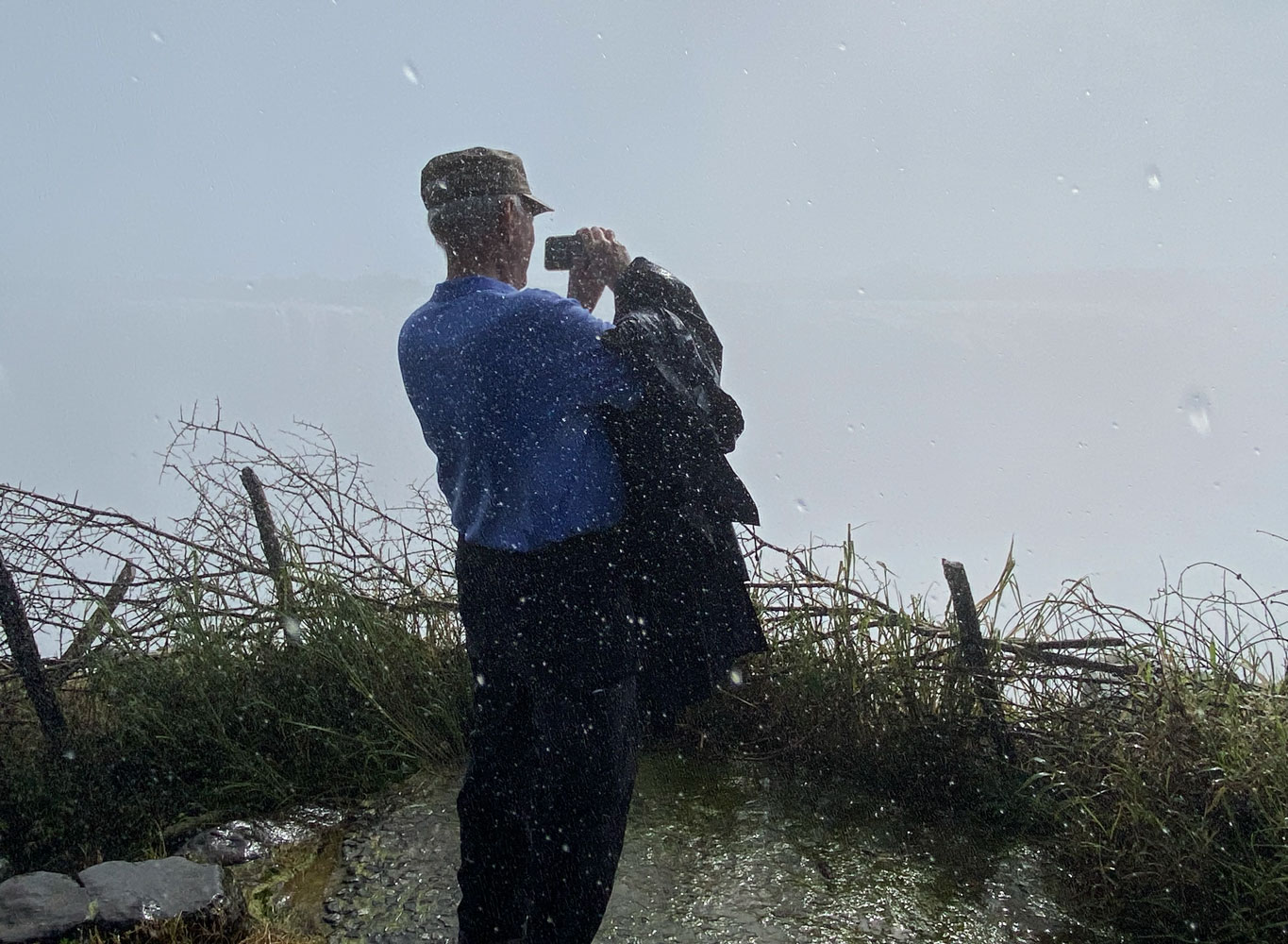
Here's Danger Point, location 15. It was really raining here and I was soaked. The footing was really slippery.
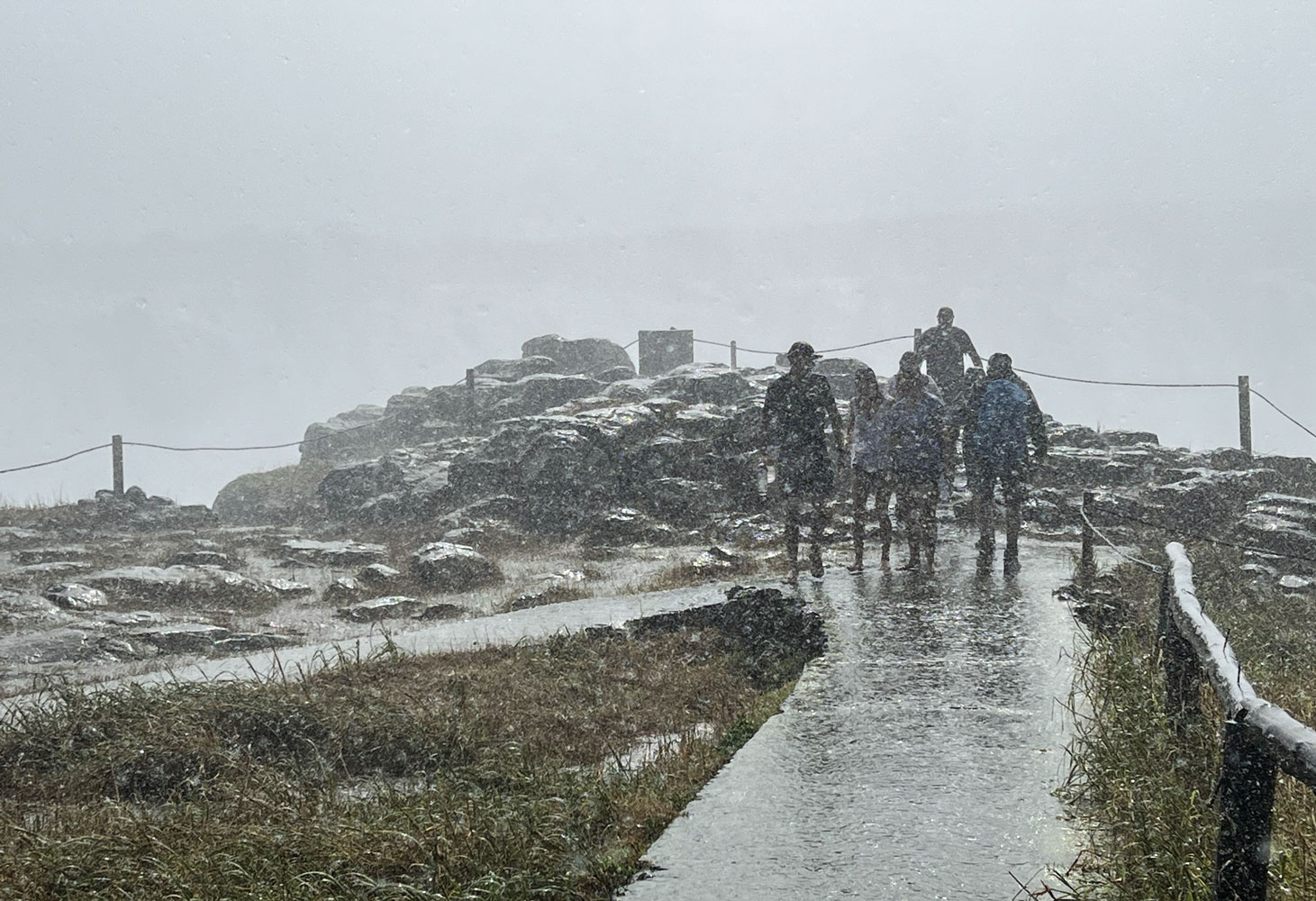
We walked to location 16 and took a picture of the bridge.

With that, we walked back to the entrance and joined the others of our group. Thomas is soaked.

After relaxing there for a while, we went back to the hotel. Judy and I turned in our wet clothes as laundry at the hotel, and they washed and dried them by the afternoon.
We then went walking into town to use the ATM (which dispensed US cash) and to have lunch. Note: The official currency of Zimbabwe is the US Dollar so ATMs dispense American cash.
We had pizza and a beer at Three Monkeys Restaurant. Both were good.

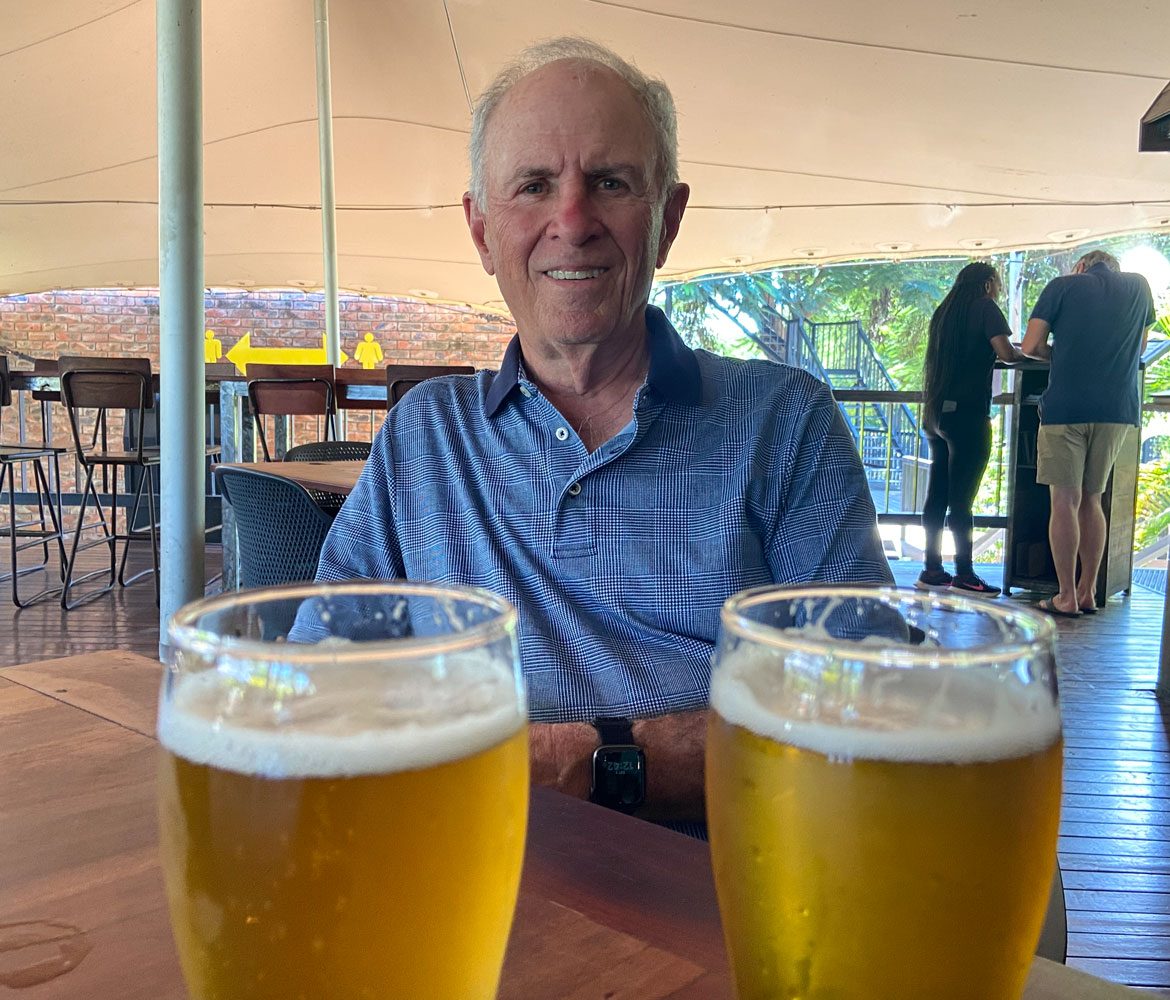
The group met at 4pm for a train and dinner excursion. We have to take the bus to Zambia, which means two passport control stops each way.
As we were driving along, we encountered a short rain shower, and a rainbow! Near the falls a rain shower can happen although the sky is perfectly clear. It's the heavy mist in the air blown in from the falling water.

We have to cross the Victoria Falls Bridge to get to Zambia, and this picture shows how the bridge is laid out - one lane of vehicle traffic, a rail line and a pedestrian walkway.

We could see the rainbow over the gorge of the falls.

Here we are boarding the train.

A view inside the train car.

The bar area.

One of the employees. They introduced him as an engineer. He was working at the rear of the train communicating with the people in the engine area.

As we rolled down the track, we could see the mist from the falls.

To get to the bridge, we have to go back into Zimbabwe. To prevent people from walking across the border on the tracks, there's a gate across the tracks which has to be opened for us to pass.

Some baboons came running out to meet us, probably looking for treats.

Isabel and Mike on the train.

Eventually, we reached the bridge.

The train rolled out to the middle of the bridge and stopped. From there, we could look down at the canyon of the Zambezi River.

In the other direction, the mist obscured the falls.

This is the steam engine that pushed the train (we went backwards to the bridge) - forward to return.

Some baboons ran out to the train and jumped up on top. Two of them started fighting.

The passengers were milling around at the back of the train, on the bridge.

Judy at the back of the train.

Judy took this picture of me taking pictures.

A view of the bridge, and the people on it, from the back of the train.

Arnaldo on the bridge.

Our esteemed tour director, Frank, looking serious.

Then it was time for us to move into the dining cars.

The train left the bridge while we were in the dining cars, and dinner was served. Service was somewhat slow, and it was about 9pm before it was finished and we left the train to board the bus. Then we had to return to the hotel and go through two passport control stations.
Overall, I thought this excursion was just too long (from 4pm to after 9pm). I would have preferred if we had just done the train ride and gone back to the hotel for dinner. That way, if people were tired, they could simply get up and go to their room.
That was the end of our day.
+++++++++++++++++++++++++++
4/9/2023 (Easter Sunday) We fly to Johannesburg today. Since the Victoria Falls Airport is in Zimbabwe, we did not have to go through any passport control. The trip to the airport was uneventful, and soon we were there.

Judy and I had an earlier fight than the rest of the people on the tour, because Jennifer made our arrangements when our trip was changed. The airport was somewhat crowded but we got through everything quickly.

The plane we're flying on is an Embraer E-145.

Since it's Easter, we were each given a chocolate lollypop with jellybeans attached as we entered the plane. And the cabin attendant was wearing bunny ears.

We arrived at the Johannesburg airport on time.

Lucky Pitso (in the white shirt) was there to meet us. Our driver is the other person in the photograph.

Just because you have a cart doesn't mean you have to wait for an elevator. Lucky just rolled the cart onto the escalator.

He drove us to the Fairlawns Hotel - a boutique hotel in Johannesburg.

Our room was in the building called the "Grand Chateau".

This hotel was "over the top." The best hotel on the tour (although all the hotels we stayed at were nice). Here's a picture of our room. Each room in the Grand Chateau was different, but from what others said, all were magnificent.
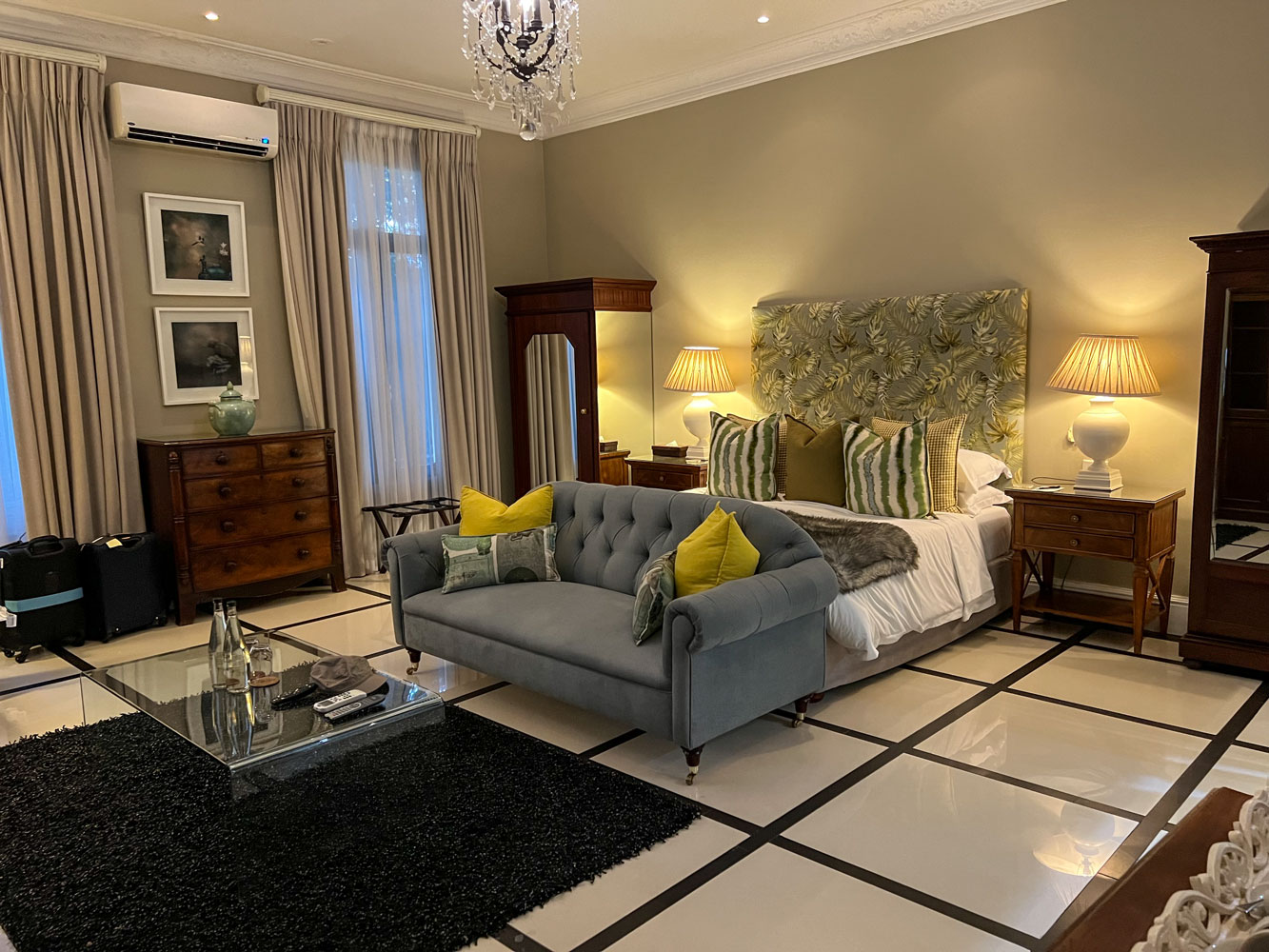
Also, a very nice bath with two sinks (which we always appreciate), a tub, and a large shower.

Internet access was very good.
The rest of the people on the tour arrived about an hour later.
For the musicians reading this, the hotel has a rare and unusual Broadwood piano.

That evening we congregated in a meeting room for a talk about the history of South Africa, given by Mary (I didn't get her last name), a very entertaining speaker.

Beverley Gossayn, the AMA Waterways representative in Johannesburg, also spoke to us.

We had a nice group dinner, and then it was off to bed.

+++++++++++++++++++++++++++
4/10/2023 (Monday) We're going to do some sightseeing in Johannesburg, specifically Soweto.
Johannesburg obviously has a crime problem, and most of the homes have walls around them, with either electrical wires strung at the top of the wall, or sharp spikes to deter anyone from coming over the wall.
Here's an example of the spikes.

Once cause may be the number of terribly poor people who live in the area. We saw quite a number of shanty-towns as we traveled to and from Soweto. By "shanty-town" I mean an area were people have built makeshift homes, usually covered sides and top with tin roofing material. Some have wood walls and tin roofs.
From what I understand, these people just moved onto the land and built their homes, so they have no legal claim to the land. But I'm getting ahead of myself. Let me tell the story of our visit.
[Side note: I saw a similar situation in Saigon during the war. People had left their villages because of security issues and come to Saigon. They built small tin shacks wherever there was room and tapped into the power lines. There was no running water or toilet facilities so the area could get fairly rank. I regret that I never took any pictures of those shacks.]
We met in the lobby this morning and boarded a mini-bus for the tour.
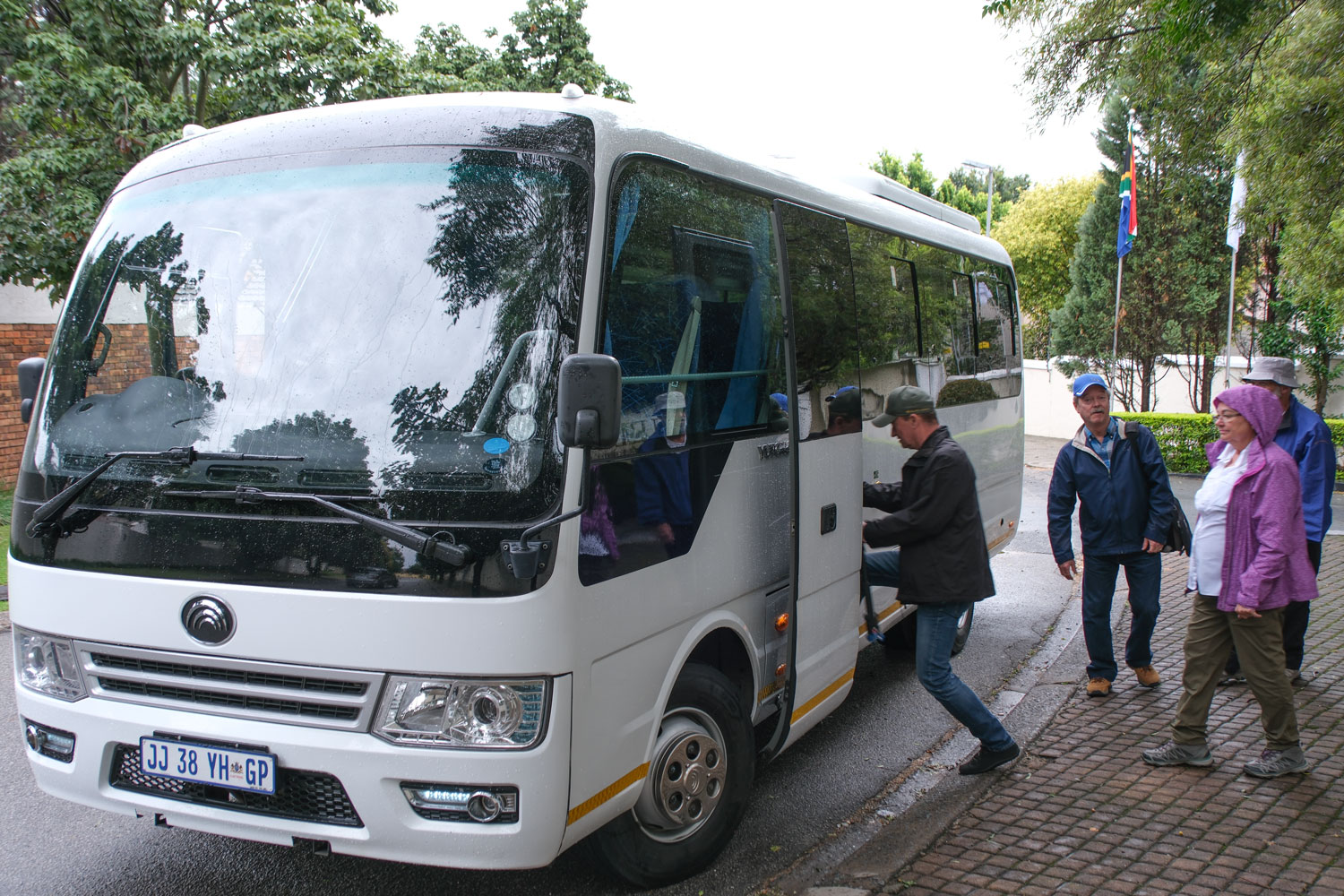
We drove to Soweto. The name "Soweto" comes from South Western Township
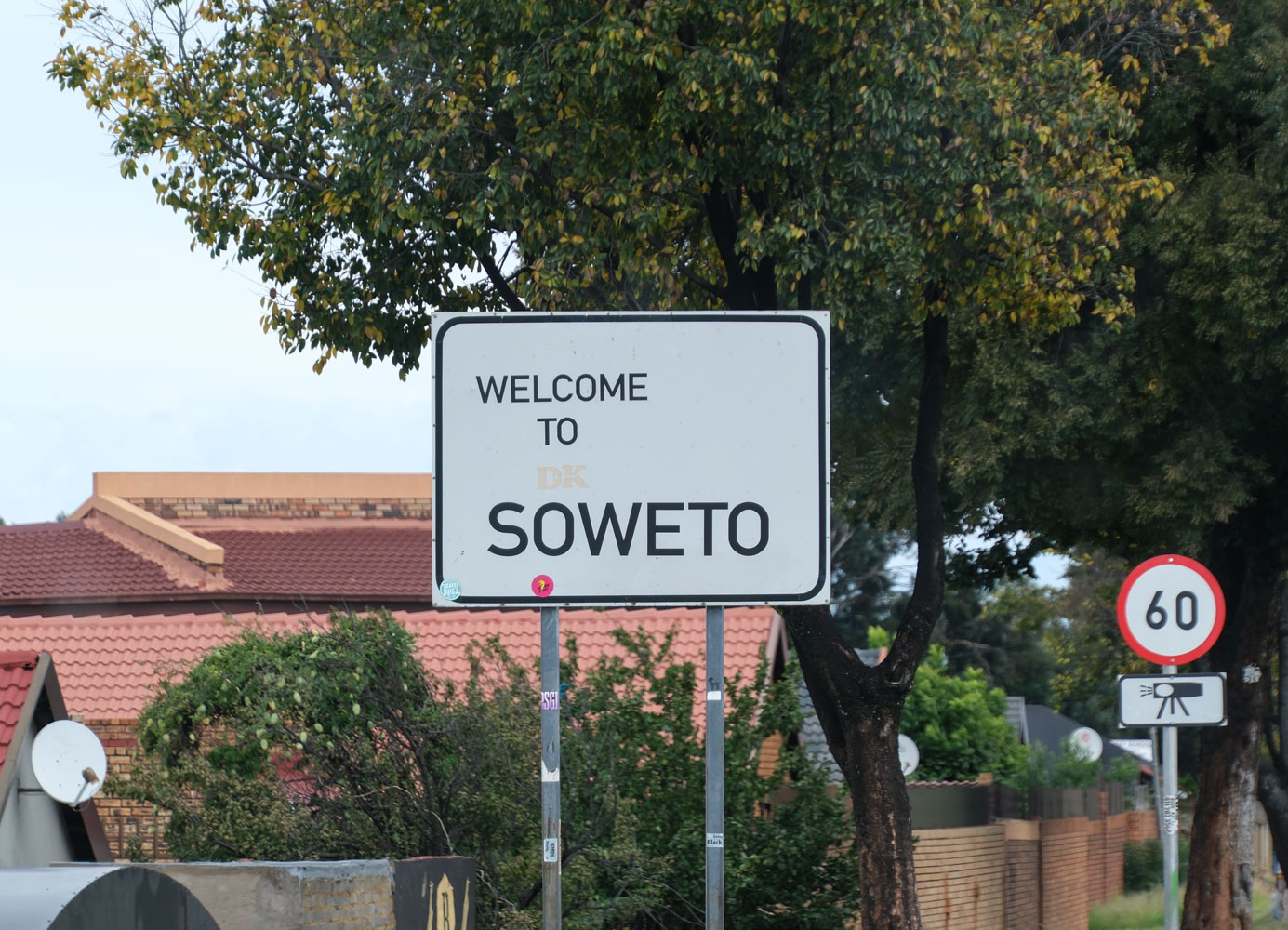
Soweto is not all shanty town - we drove down some streets which were very nice and had well maintained neighborhoods and homes.


But the focus of our tour was the shanty-town area. Here are a few pictures of the structures in that area.



We stopped beneath a bridge, where there was an entrance to the town, and met our guide, Thulani. He had been born and raised in Soweto.

He led us through the town. I didn't take many pictures, to respect the privacy of the residents.
Thulani gave us a briefing before going into the town. There is some electricity, but it's brought into the town by the people wiring together any wire they have and connecting it to whatever poles or structures they can. Not what I'd call safe or reliable.

The government has installed "port-a-potties" at the entrance to the town. Each of the potties is assigned to a group of people, and a lock is on the door, so access is limited to that group only.

The streets were narrow dirt alleys.

A house we passed on the walk.

We came to an open area where the government had installed a couple of water pipes, so people could have clean water. The "plaza", as I'll call it, was just bare dirt.

Just off this plaza was a school, built by private donation, to offer an education to the children.

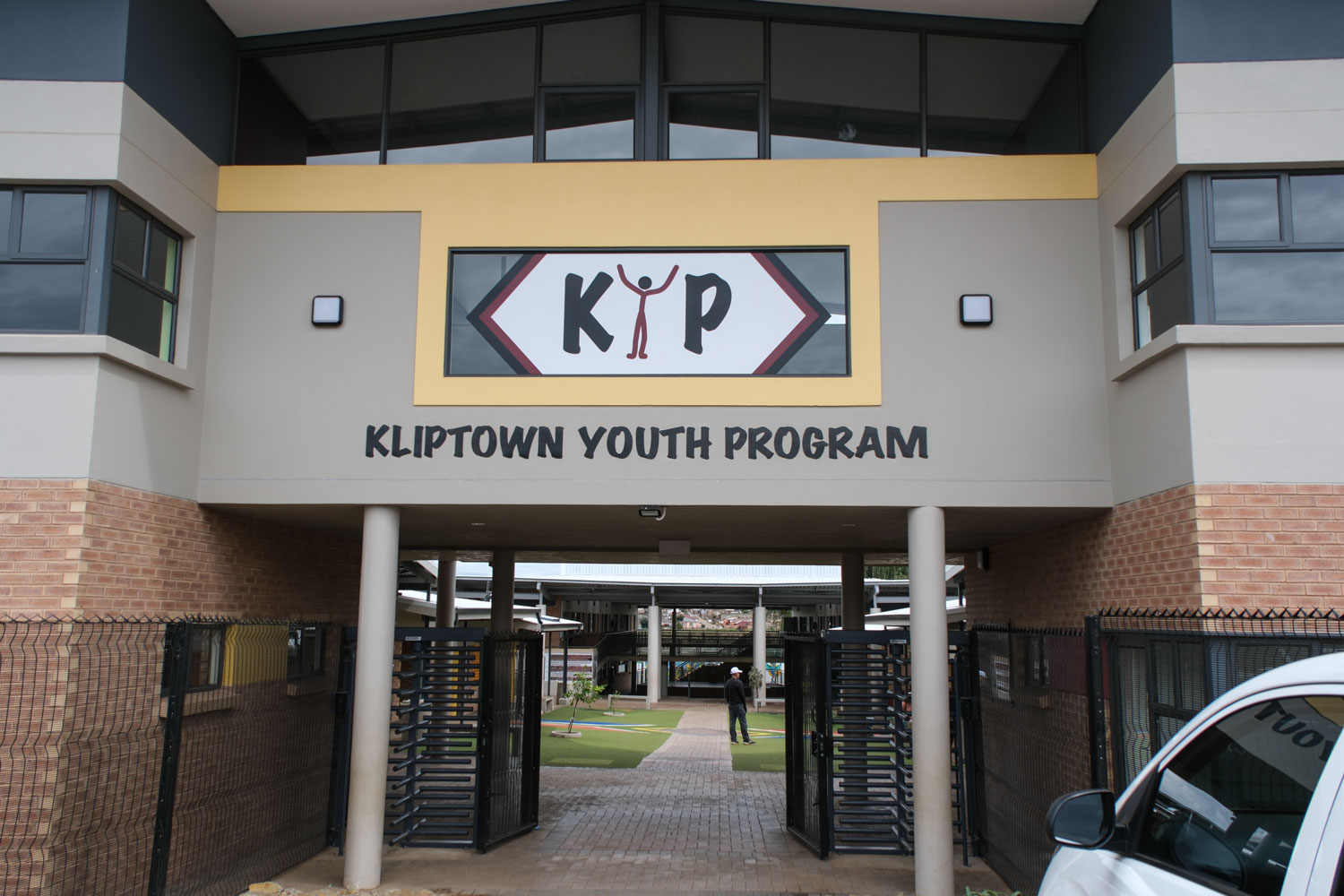
It's a very nice, modern facility. This was the primary focus of our tour.

The kids all wear uniforms so that economic differences between the students is not obvious.

The computer room.

For Easter, they had hidden candy around the campus, and they allowed the kids to search for it. Here they are running into the campus. School was out for Easter vacation, so they are not in uniform.

They have a kitchen that serves meals for the kids. Here's the menu.

I want you to notice Thursday's lunch. I grew up on a poultry farm, and I can tell you that there's not much meat on chicken feet. Pap is cooked white corn meal. It's cooked very stiff. In Louisiana, we cooked white corn meal, and called it grits, but it was not as stiff as pap.

After a bit, we left Soweto to go to lunch. On the way, we passed other shanty towns. Here's a picture of one, taken from the bus. It had rained and the window had water droplets on it, so the picture is not as clear as it could be.

A closer view.

For lunch we went to Sanctuary Mandela, a museum of Mandela's life.

Here's a view of the building.

In the entry archway is a statue of Mandela reading a newspaper, which he did on a daily basis.

There's some sheet music framed and hanging on the wall.
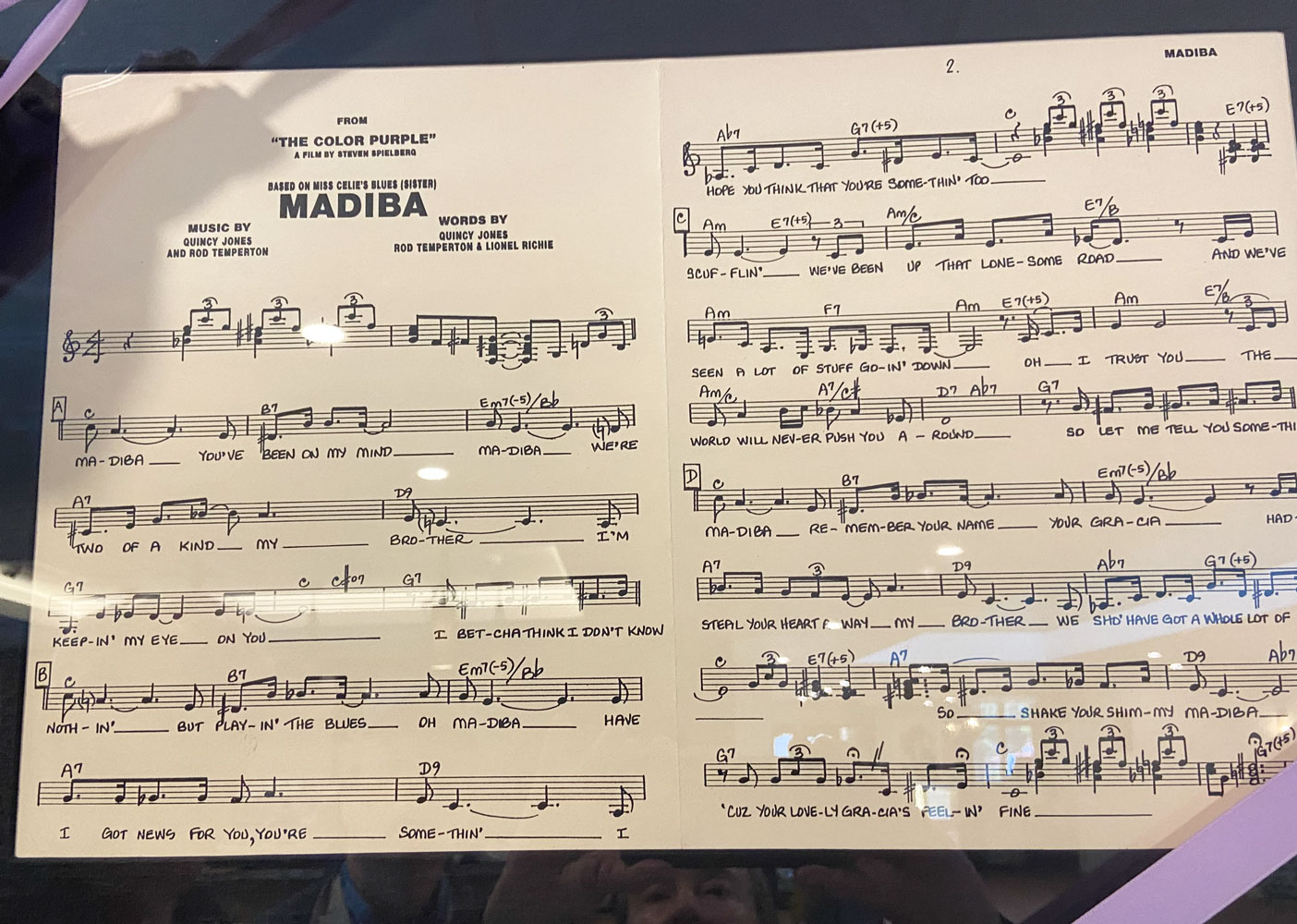
Here we are at lunch.

Here's that electric wire I mentioned earlier, used on the top of the fence. I don't know how dangerous it is, but I suspect it will give you quite a shock.

After lunch we returned to the hotel and had the rest of the day to ourselves.
I'll end this page here. Tomorrow, we fly to the Kruger National Park.